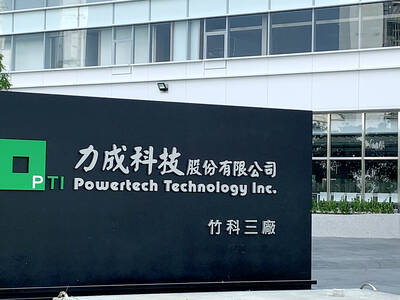Prices of computer memory chips may rebound during the first quarter of next year as chipmakers cut production to cope with the drastic price corrections of the past few months, Taipei-based market researcher DRAMeXchange said last week.
Taiwanese chipmakers, well-known for their strong cost-saving ability, are now under pressure from price erosion after a 50-percent decline in prices pushed them into the red, or to the brink of losses during the second quarter of this year.
Following the third quarter recovery, prices for dynamic random access memory (DRAM) chips started on a downward trend again, according to DRAMeXchange.
Contract prices for banker double-data-rate (DDR) DRAM modules have fallen 22 percent since September when compared to the previous three months, the researcher said in a statement.
The price for DDR2, which processes data faster dipped by about 32 percent, it said.
"Faced with the prospect of further price drops, DRAM chipmakers started cutting back production," DRAMeXchange said.
Last month, the annual growth for total DRAM output slowed to around 2.65 percent, compared with around a 10-percent increase for September and October, respectively, the research house said.
Combined with a lack of supplies, lower chip prices have stimulated unusually strong demand this month, which used to be a slow month as computer vendors traditionally reduce their inventory dramatically after the annual Christmas shopping spree ends, the report noted.
"That indicates that contract prices are hitting the bottom and there is a chance they may rebound," the research house said.
DRAM chipmakers attempted to inflate the contract price slightly for the second half of this month in light of improved spot prices, but most of them got flat deals, researcher said.
Some still managed to raise prices and extended the price negotiations with their US customers ahead of the Christmas holidays, the researcher added.
Despite the bumpy road toward price hikes, most DRAM makers held an optimistic attitude about the market, according to DRAMeXchange's survey.
They planned to raise prices for the first half of next month and prices would be sustainable during the first half of the first quarter of next year, the researcher said.
The contract price for the benchmark 256-megabit, 400-megahertz DDR DRAM chip was unchanged at US$1.98 from last month, according to the report.
The spot price for the benchmark DRAM chip fell nearly 20 percent to US$2.1 on Friday from an average of US$2.6 in the third quarter.
DRAM makers such as Taiwan's second-largest memory chipmaker Nanya Technology Corp (

US sports leagues rushed to get in on the multi-billion US dollar bonanza of legalized betting, but the arrest of an National Basketball Association (NBA) coach and player in two sprawling US federal investigations show the potential cost of partnering with the gambling industry. Portland Trail Blazers coach Chauncey Billups, a former Detroit Pistons star and an NBA Hall of Famer, was arrested for his alleged role in rigged illegal poker games that prosecutors say were tied to Mafia crime families. Miami Heat guard Terry Rozier was charged with manipulating his play for the benefit of bettors and former NBA player and

The DBS Foundation yesterday announced the launch of two flagship programs, “Silver Motion” and “Happier Caregiver, Healthier Seniors,” in partnership with CCILU Ltd, Hondao Senior Citizens’ Welfare Foundation and the Garden of Hope Foundation to help Taiwan face the challenges of a rapidly aging population. The foundation said it would invest S$4.91 million (US$3.8 million) over three years to foster inclusion and resilience in an aging society. “Aging may bring challenges, but it also brings opportunities. With many Asian markets rapidly becoming super-aged, the DBS Foundation is working with a regional ecosystem of like-minded partners across the private, public and people sectors

BREAKTHROUGH TECH: Powertech expects its fan-out PLP system to become mainstream, saying it can offer three-times greater production throughput Chip packaging service provider Powertech Technology Inc (力成科技) plans to more than double its capital expenditures next year to more than NT$40 billion (US$1.31 billion) as demand for its new panel-level packaging (PLP) technology, primarily used in chips for artificial intelligence (AI) applications, has greatly exceeded what it can supply. A significant portion of the budget, about US$1 billion, would be earmarked for fan-out PLP technology, Powertech told investors yesterday. Its heavy investment in fan-out PLP technology over the past 10 years is expected to bear fruit in 2027 after the technology enters volume production, it said, adding that the tech would

YEAR-END BOOST: The holiday shopping season in the US and Europe, combined with rising demand for AI applications, is expected to drive exports to a new high, the NDC said Taiwan’s business climate monitor improved last month, transitioning from steady growth for the first time in five months, as robust global demand for artificial intelligence (AI) products and new iPhone shipments boosted exports and corporate sales, the National Development Council (NDC) said yesterday. The council uses a five-color system to measure the nation’s economic state, with “green” indicating steady growth, “red” suggesting a boom and “blue” reflecting a recession. “Yellow-red” and “yellow-blue” suggest a transition to a stronger or weaker condition. The total score of the monitor’s composite index rose to 35 points from a revised 31 in August, ending a four-month